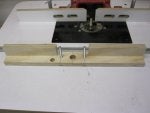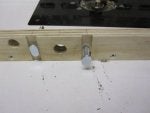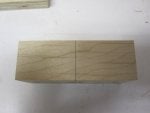Some of you showed an interest in my dowel making jig that I made while making my wooden bucket truck. As promised, I'll try and go through the steps that it takes to make your own and hopefully, I will be able to explain it well enough that you guys will understand my twisted logic. If there are any questions, feel free to ask and I will try and clarify it.
For my jig, I use a 1/2" straight bit in the router table. You can use whatever size of straight bit that you like, but you will have to adjust your hole sizes in your jig accordingly.
![]()
I made an 18" long fence that is approximately 2" high. Be sure that the fence that you make is square. You don't have to make this in the form of a fence if you don't want to. A flat board will work just fine, but I wanted to clamp mine to my existing router table fence instead of clamping it to the table. Whatever method you choose, you will need to drill a centered, 3/4" through hole for the router bit to protrude from. The hole that you see on the left of that centered hole, is one that I drilled as an access hole for my router lift system. I also turned a little cover for this hole so that it would not fill up with chips while using the jig.
![]()
I then had to cut a couple of shallow dadoes in the bottom of the jig, to accept the T-bolts that I will be using to hold my dowel cutting blocks in place. Again, you don't have to go this route. You could use wing nuts or whatever you have on hand. I used these T-nuts because I have a stock of jig hardware that was crying to be used.
![]()
Now that your fence is done, you need to make your dowel cutting blocks. I made mine 4" X 1 7/8" X 1 5/8" but you can make yours whatever size fits your particular jig. You want to make these blocks out of hard wood, as they will take some serious abuse. I made mine out of hard maple. Once you have your block cut, you want to mark a center line all the way around the block. In this case, the line is at 2" on every side.
![]()
At this point, you need to drill 3 holes. 2, that will line up with your T-bolts for fastening the blocks in place, and a 5/8" hole in the bottom that will accept your straight bit. The hole for the straight bit is only drilled to 1/2 way into the dowel cutting block. Give yourself a little extra play in the T-bolt holes as this will give you a little more flexibility for fine adjustments, should your cuts be a little off.
![]()
For my jig, I use a 1/2" straight bit in the router table. You can use whatever size of straight bit that you like, but you will have to adjust your hole sizes in your jig accordingly.

I made an 18" long fence that is approximately 2" high. Be sure that the fence that you make is square. You don't have to make this in the form of a fence if you don't want to. A flat board will work just fine, but I wanted to clamp mine to my existing router table fence instead of clamping it to the table. Whatever method you choose, you will need to drill a centered, 3/4" through hole for the router bit to protrude from. The hole that you see on the left of that centered hole, is one that I drilled as an access hole for my router lift system. I also turned a little cover for this hole so that it would not fill up with chips while using the jig.

I then had to cut a couple of shallow dadoes in the bottom of the jig, to accept the T-bolts that I will be using to hold my dowel cutting blocks in place. Again, you don't have to go this route. You could use wing nuts or whatever you have on hand. I used these T-nuts because I have a stock of jig hardware that was crying to be used.

Now that your fence is done, you need to make your dowel cutting blocks. I made mine 4" X 1 7/8" X 1 5/8" but you can make yours whatever size fits your particular jig. You want to make these blocks out of hard wood, as they will take some serious abuse. I made mine out of hard maple. Once you have your block cut, you want to mark a center line all the way around the block. In this case, the line is at 2" on every side.

At this point, you need to drill 3 holes. 2, that will line up with your T-bolts for fastening the blocks in place, and a 5/8" hole in the bottom that will accept your straight bit. The hole for the straight bit is only drilled to 1/2 way into the dowel cutting block. Give yourself a little extra play in the T-bolt holes as this will give you a little more flexibility for fine adjustments, should your cuts be a little off.
















